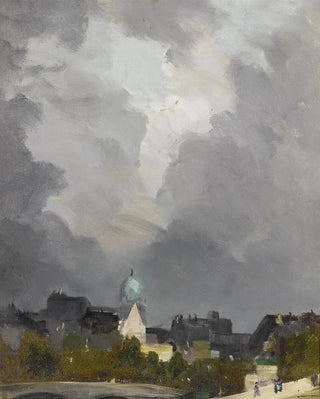Art print | In Amsterdam - Robert Henri


View from behind

Frame (optional)
Art print À Amsterdam - Robert Henri – Engaging Introduction
In the vast panorama of art history, certain works stand out for their ability to capture the essence of a particular era, city, or emotion. "À Amsterdam - Robert Henri" is a striking example. This painting, depicting the vibrant life of Amsterdam's streets, transports the viewer to the heart of this iconic city, where every brushstroke seems to resonate with the whispers of history. Henri, through his talent, manages to create an atmosphere that is both intimate and universal, inviting everyone to immerse themselves in this scene of everyday life. The piece presents itself as an open window to a world rich in color, light, and movement, where the past and present converge.
Style and uniqueness of the work
Robert Henri's style is often characterized by his bold and expressive approach to painting. In "À Amsterdam," he uses a palette of vibrant colors, blending warm and cool shades to bring the scene to life. The human figures, though stylized, are imbued with profound humanity, each face telling a story, each gesture capturing an emotion. Henri excels in the art of light, playing with shadows and reflections to create an atmosphere that is both dynamic and soothing. This art print is not just a simple representation; it evokes a sensory experience, where one can almost feel the noise of the canals, the aroma of coffee, and the bustle of conversations intertwining in the air. Every detail, from the movement of the characters to the nuances of the buildings, reflects meticulous observation and a deep understanding of urban life.
The artist and his influence
Robert Henri, an emblematic figure of the Ashcan School movement, knew how to mark his era with his commitment to depicting the daily life of the working classes. Born at the end of the 19th century, he is part of a tradition that values realism and authenticity. Henri does not limit himself to capturing the surface of things; he seeks to reveal the emotions and hidden stories behind each face, each scene. His influence extends well beyond his time, inspiring many artists to explore urban life from a new perspective. Through

Matte finish

View from behind

Frame (optional)
Art print À Amsterdam - Robert Henri – Engaging Introduction
In the vast panorama of art history, certain works stand out for their ability to capture the essence of a particular era, city, or emotion. "À Amsterdam - Robert Henri" is a striking example. This painting, depicting the vibrant life of Amsterdam's streets, transports the viewer to the heart of this iconic city, where every brushstroke seems to resonate with the whispers of history. Henri, through his talent, manages to create an atmosphere that is both intimate and universal, inviting everyone to immerse themselves in this scene of everyday life. The piece presents itself as an open window to a world rich in color, light, and movement, where the past and present converge.
Style and uniqueness of the work
Robert Henri's style is often characterized by his bold and expressive approach to painting. In "À Amsterdam," he uses a palette of vibrant colors, blending warm and cool shades to bring the scene to life. The human figures, though stylized, are imbued with profound humanity, each face telling a story, each gesture capturing an emotion. Henri excels in the art of light, playing with shadows and reflections to create an atmosphere that is both dynamic and soothing. This art print is not just a simple representation; it evokes a sensory experience, where one can almost feel the noise of the canals, the aroma of coffee, and the bustle of conversations intertwining in the air. Every detail, from the movement of the characters to the nuances of the buildings, reflects meticulous observation and a deep understanding of urban life.
The artist and his influence
Robert Henri, an emblematic figure of the Ashcan School movement, knew how to mark his era with his commitment to depicting the daily life of the working classes. Born at the end of the 19th century, he is part of a tradition that values realism and authenticity. Henri does not limit himself to capturing the surface of things; he seeks to reveal the emotions and hidden stories behind each face, each scene. His influence extends well beyond his time, inspiring many artists to explore urban life from a new perspective. Through






